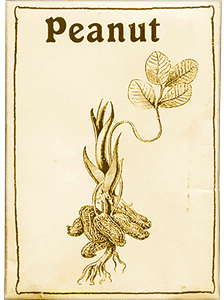PEANUT
Vitals
• Arachis hypogea , belonging to the legume family, Fabaceae/Leguminosae.
• Origin: South America.
• Early cultivation: 2500 BC.
• Early archeological evidence: Peanut shells found in excavation sites in Peru date back to 2500 BC.
• Evidence of other early cultivation: Ancient pottery jars shaped like or filled with peanuts have been found in Brazil, Peru, and along the western coast of South America.
• Climate: Warm weather, long growing season.
• Major producing countries: China, India, Nigeria.
Short historyThe peanut plant is nothing short of miraculous. Its flowers bloom one day, wilt the next, then put out a stalklike “peg” that grows downward, burrowing into the ground. Peanut pods form at the end of the peg and mature in the under-soil darkness.
Peanuts aren’t nuts at all; they are legumes, like peas and beans. The European conquistadors were skeptical of this “groundnut” when South American Indians introduced them to it. But when these explorers ventured to Africa with their find, people there welcomed the bean. In the 1700s and 1800s, when thousands of West Africans were taken from their homes to be traded as slaves in the New World, peanuts came along and nourished them. White Americans considered “goobers” (from nguba , the Banta name for peanuts) to be animal food until Civil War troops found themselves hungry in the trenches and discovered the peanut’s nutritional value. Peanuts became a commonplace food in the early 1900s, when the industrial revolution brought machinery that made them easy to harvest. Today, peanuts are grown on six continents and consumed everywhere in the world.
Peanut facts and loreNorth Americans can’t lay claim to the invention of peanut butter. South American Indians ground peanuts into a spreadable paste 3,000 years ago. Today, over half of the United States peanut crop becomes peanut butter.
In some African cultures, the peanut plant is believed to have a soul, and its importance is portrayed in bronze and iron castings.
In the 1870s, roasted peanuts appeared for sale at baseball games, circuses, and theaters. Spectators in cheap balcony seats munched goobers, shouted commentary, and were derisively known as the “peanut gallery.”
In the early 1900s, George Washington Carver discovered more than 300 uses for peanuts. When insects destroyed cotton crops in 1905, he saved many Southern farms by convincing farmers to switch from cotton to peanuts.
Saving the seed
The peanut itself is the seed for the plant. They are easy to save, if you can resist munching everything you’ve harvested.
Plant only one variety of peanut in your garden if you want to save seeds.
• To harvest, pull up the whole peanut plant, including the pegs and the peanuts hanging from them, toward the end of the season. This will require digging deep enough to avoid cutting the shoots. In more northern climes, the plants may not turn yellow. Harvest them after the first killing frost.
• Leave the plants to cure in the garden or in a frost-protected shelter for two to three weeks.
• Strip the pods from the pegs and store in a cool, dry place.
• Peanuts are particularly susceptible to a variety of hazards: mold, insects, rodents, and rancidity. To avoid these perils, make sure the peanuts are kept very dry and are protected from the invasions of small animals.
• In spring, plant the seeds when the ground is warm (70–80 °F; 20–26 °C).
Saving and planting seeds is easy. Make sure that the plants you are saving seed from are what’s called an “open-pollinating” rather than a hybrid variety. For a list of companies that sell seeds for open-pollinating plants, see our article Why Save Seeds?
